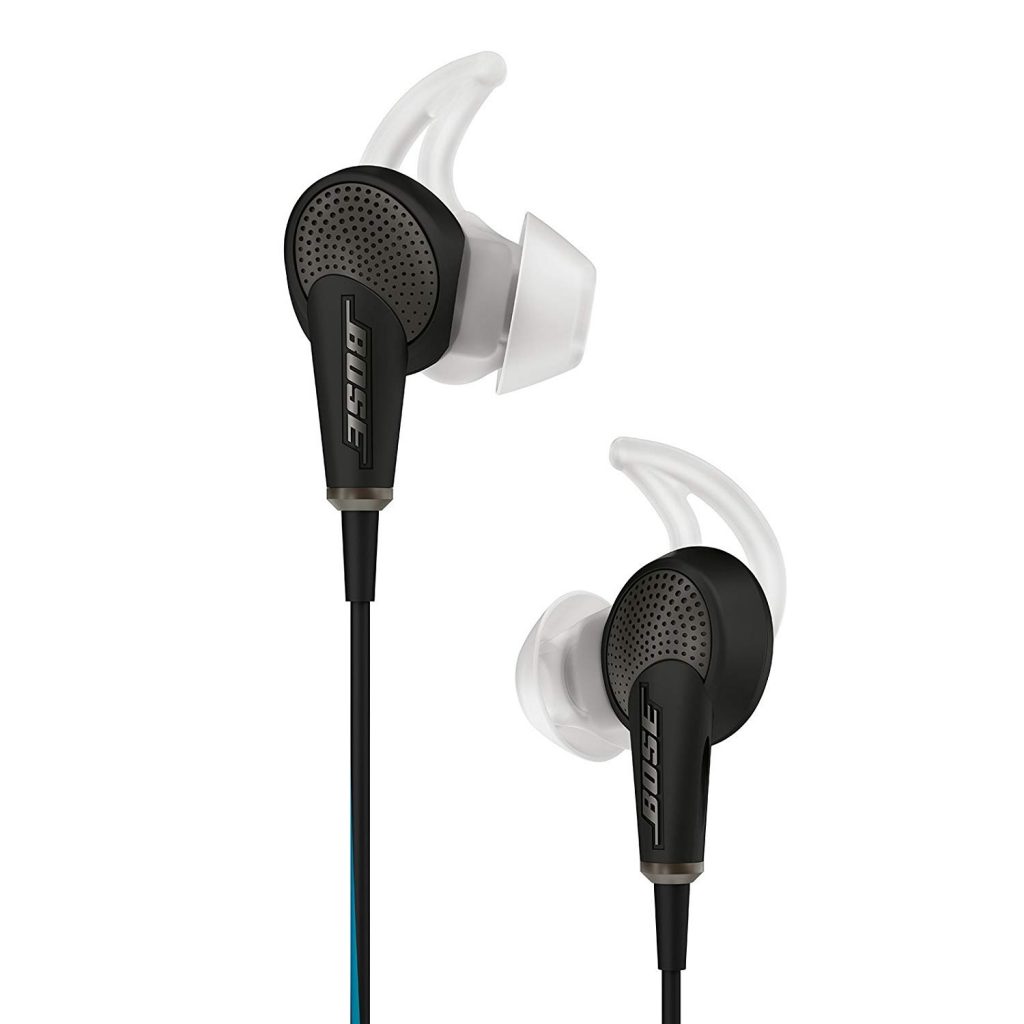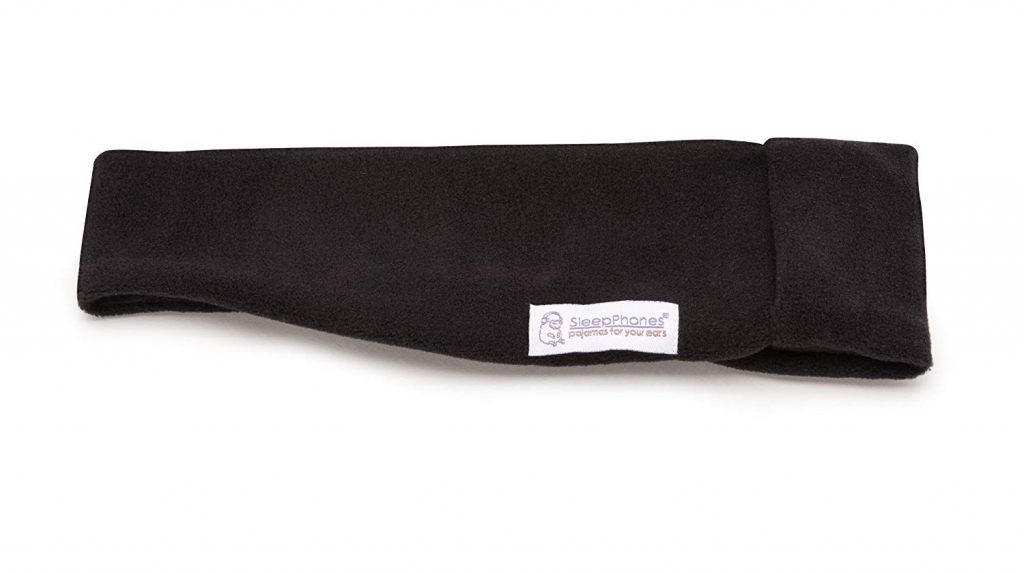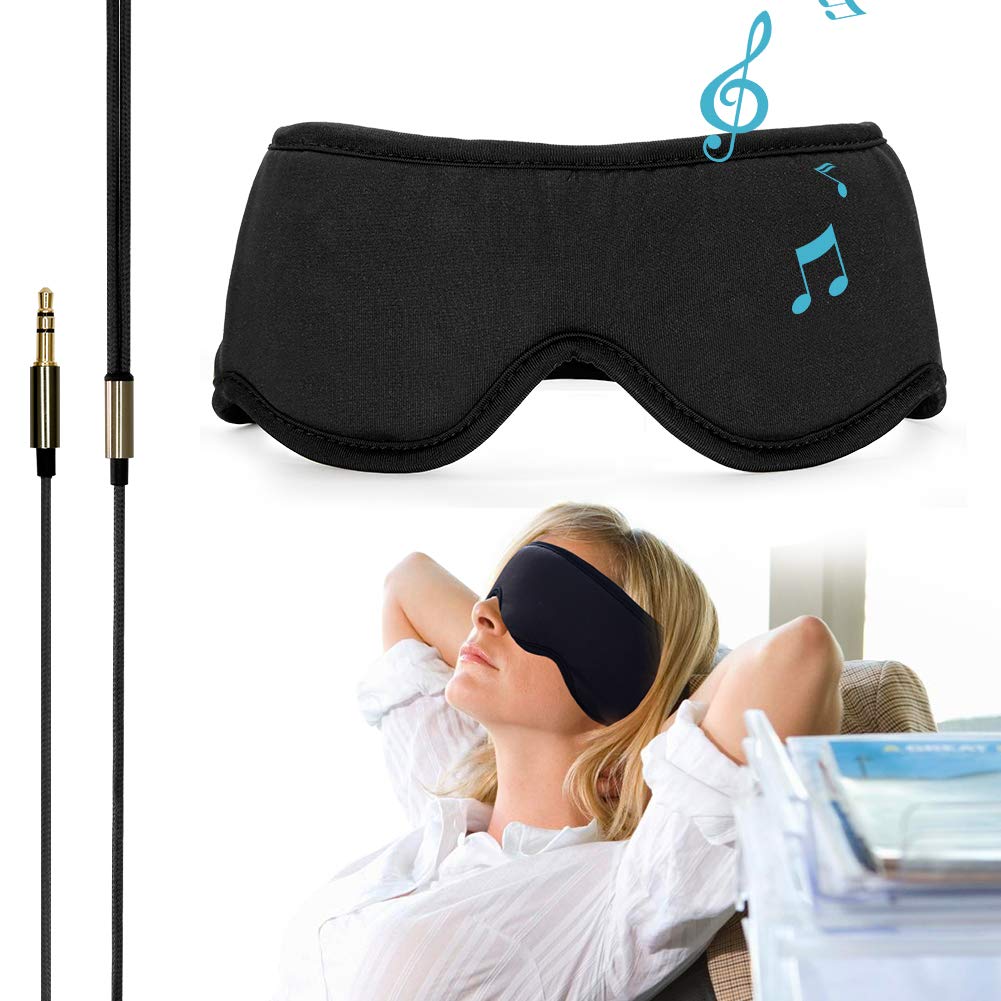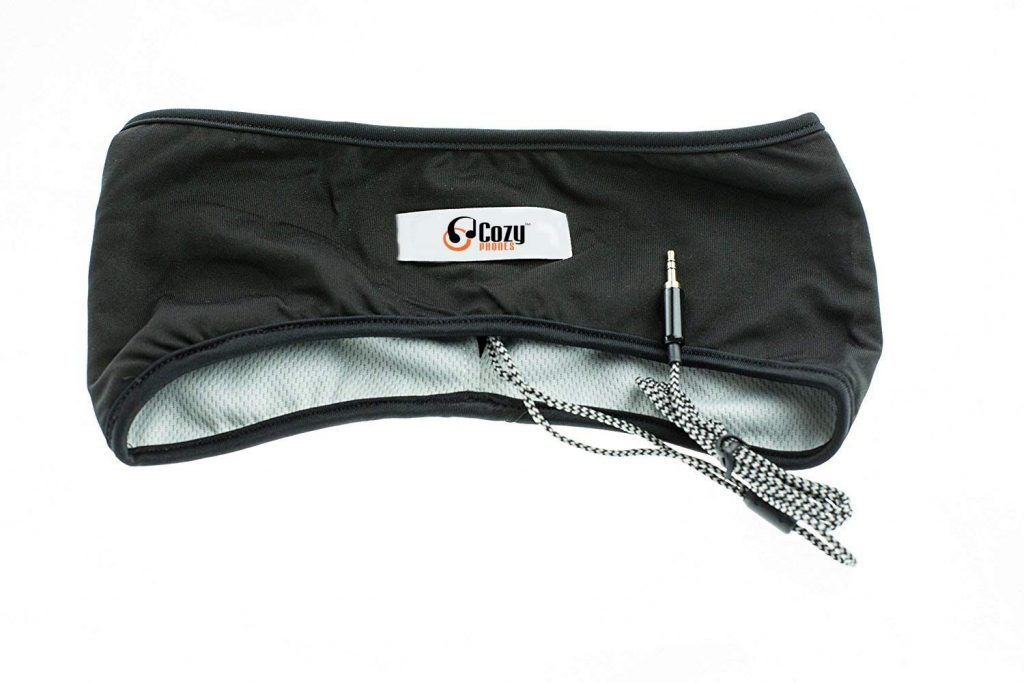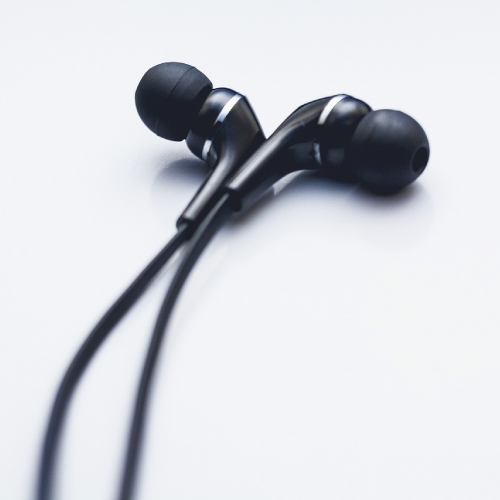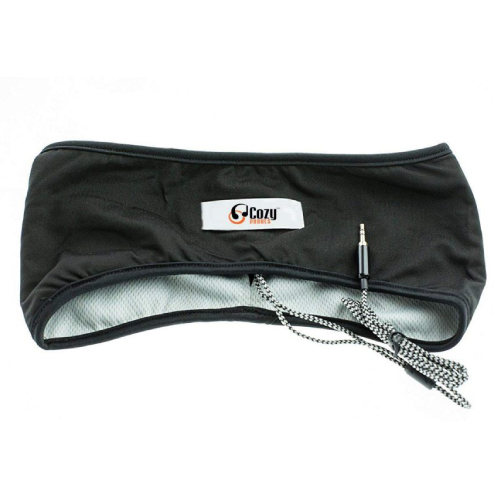Table of Contents
Is your mind racing every night, going over the things you have to do tomorrow or reminding you about that embarrassing thing you said back in high school? Or is your new upstairs neighbor having a house-warming party for the fourth time this week?
You desperately need a relaxing night of sleep, but can’t seem to catch a break. Sleeping earbuds aren’t much of a help and your standard iPhone earphones are just too uncomfortable to consider sleeping with them. Well, you might finally catch a break, because you came to the right place for a useful piece of advice.
Here you’ll learn all about what kind of headphones are the best ones to make your neighbors’ party disappear, which sleeping headphones are the best for playing ASMR videos that soothe your mental chatter and at what cost will all of that come.
Now sit back, relax and read. Well, you’re not sleeping so that’s the best thing you can do right now, eh?
Best Headphones for Sleeping – Editor’s pick
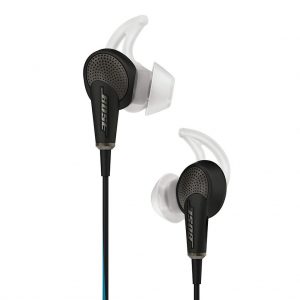 |
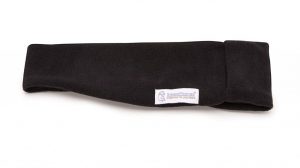 |
 |
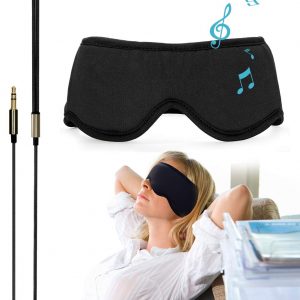 |
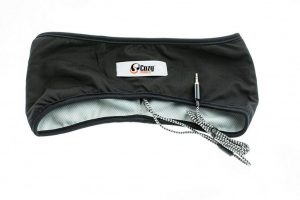 |
How We Review Headphones for Sleep and What to Expect from this Guide
● We prefer comfortable headphones over all others and will focus on these; that means a heavy focus on headbands.
● We highly prefer wireless headphones for sleep and almost all of our suggestions fall into this category.
Reviews of Headphones
With all the different types of headphones, different technologies and purposes, choosing just the right headphones can be a frustrating task. We’ll go over five different types of sleep headphones, reviewing their strongest and weakest points.
1. Absolute Best Headphones to Sleep In: Bose 718840-0010 QuietComfort 20
Who is it for
These headphones are made for people who want the absolute best sound quality in noise-canceling headphones, no matter the price.
Pros and Cons of Bose 718840-0010 QuietComfort 20 Headphones
| Pros | Cons |
|
|
All you need to know about Bose 718840-0010 QuietComfort 20 Headphones
Bose is a well-established company, with long-term experience in making noise-canceling devices. In fact, Dr. Amar Bose is the person who invented the first noise-canceling headset to help airplane pilots concentrate during flights. Their QuietComfort headphone series has been helping people zone out annoying sounds since the 2000s.
The model we are looking at is their first in-ear, active noise-canceling model. Although it came out in 2013, it is still the best out there – and it holds its price. Bose QuietComfort 20 uses a mixture of active and passive noise-canceling technologies. The Stay Hear+ tips don’t pressure your ear canals, as most of the earbuds do, what makes them fairly comfortable headphones for sleeping, despite the fact it’s not their primary function. Apart from that, their unique design is responsible for their passive noise-cancellation capabilities. Unlike their previous model (QC 15), you can turn the Aware mode on, and continue listening to music, without the active noise-cancellation. This can come in handy if you have to pay attention to your surroundings during the night (eg. child, pet).
Bose 718840-0010 QuietComfort 20 Headphones Tech Specs & Accessories
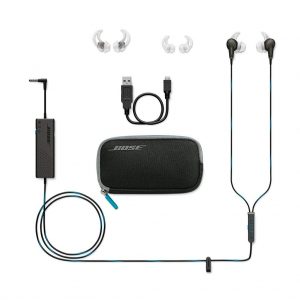 Bose 718840-0010 QuietComfort 20 headphones come with a small, travel-friendly carrying case, three pairs of Stay Hear+ tips in different sizes (S, M, L), rechargeable lithium-ion battery, USB charging cable and a clothing clip.
Bose 718840-0010 QuietComfort 20 headphones come with a small, travel-friendly carrying case, three pairs of Stay Hear+ tips in different sizes (S, M, L), rechargeable lithium-ion battery, USB charging cable and a clothing clip.
The headphones aren’t wireless, although they do have a 52” long cord, which is long enough if you don’t toss and turn a lot during the night. If that’s not the case, you will probably wake up a bit tangled up. If you’re a tosser and turner or a side-sleeper, wireless sleep headbands might be the way to go for you. You can learn about them further down this article.
As we mentioned above, QC 20 headphones have a rechargeable lithium battery. Battery lasts for up to ~16 hours of active usage, while it needs only two hours to recharge fully. The battery pack is a bit bulky and the USB charging cable is a bit too short, which can be an inconvenience on the road. But, if you’re using the headphones mainly for sleep, this won’t be much of a problem.
2. Most Comfortable Wireless Sleep Headphones – Also the Best Headphones for ASMR: AcousticSheep SleepPhones Wireless
Who is it for
If you are a light, yet fidgety sleeper, these are the headphones for you. They were made with the purpose to be the most comfortable bed headphones for anyone out there – tossers, side sleepers, light sleepers, and they are pretty good in achieving that.
Pros and Cons of AcousticSheep SleepPhones
| Pros | Cons |
|
|
All you need to know about AcousticSheep SleepPhones
AcousticSheep SleepPhones are specially made headband headphones for sleeping. They are wireless, so they provide you with all the freedom to toss and turn around the bed, without you worrying about something breaking or your phone falling. With all the difficulties falling (and staying) asleep, you don’t need that kind of worry over your head too, right?
As we already mentioned it – they were made to be the most comfortable headphones for sleeping, so their design is their foremost feature. With their headband-type design, with ultra-thin headphones positioned inside it, they provide the ultimate sleeping experience. No cables, no painful earbuds, no bulky headphones or making peace with sleeping on your back forever just so you wouldn’t wake up with sore ears tomorrow morning. And they can double as a sleeping mask with headphones in it. Wonderful, isn’t it?
All of the features mentioned above, come at a price – sound quality. It isn’t bad, but it isn’t the best out there, also. They can’t double as a noise-canceling headband for sleeping, so if you’re sleeping in a loud environment, they might not help a lot. But, you’ll be able to listen to podcasts, audiobooks and music without interrupting your partners’ sleep. The volume isn’t too high, but the sound is exceptionally clean. This makes them great ASMR headphones, even better than some ASMR earbuds.
AcousticSheep SleepPhones Tech Specs & Accessories
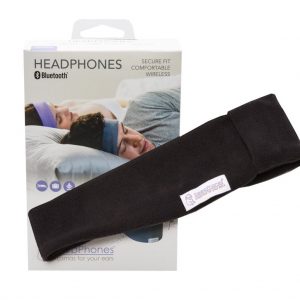 With them being Bluetooth headphones for sleeping, AcousticSheep SleepPhones easily sync with smartphones, computers and any other Bluetooth compatible device. Their wireless range is 15-30 feet for easy connectivity.
With them being Bluetooth headphones for sleeping, AcousticSheep SleepPhones easily sync with smartphones, computers and any other Bluetooth compatible device. Their wireless range is 15-30 feet for easy connectivity.
They have a rechargeable battery, which can last up to ten hours. Charging time is about three hours. On the downside, the battery lifespan decreases over time to about 7 to 8 hours. This wouldn’t be much of a problem, except the device notifies you when it’s about to shut down and disrupts your sleep by doing that.
The headband is machine washable, after you have removed all the electronics from it, of course. It comes in six different colors and two types of material, one warm and fuzzy and one breathable for warm summer nights.
Conclusion
For anybody who’s unable to fall asleep without headphones, but is tired of waking up with sore ears or with a cord around their neck – AcousticSheep SleepPhones are the right choice. With the comfortable headband solution, good battery life and the clear sound they provide, many peaceful nights are guaranteed with them.
3. Best Noise Cancelling Earbuds for Sleeping: Shure SE215-CL Sound Isolating Earphones
Who is it for
If you’re looking for earphones that would be great both for sleep and for everyday use, you should definitely pay attention to Shure SE215-CL Sound Isolating Earphones. As they were primarily made for musicians on stage, they guarantee the perfect sound, along with the comfort their design offers.
Pros and Cons of Shure SE215-CL Sound Isolating Earphones
| Pros | Cons |
|
|
All you need to know about Shure SE215-CL Sound Isolating Earphones
Although Shure SE215-CL Sound Isolating Earphones weren’t primarily made to be used as sleep earbuds, they certainly managed to be one of the most comfortable earbuds you can sleep in. They were made to be used as in-ear monitors for musicians, so they could hear their instruments better while performing on stage. Most professional musicians have their in-ear monitors custom made, so they can provide maximum comfort and high level of noise reduction. Shure wanted to make in-ear monitoring available to all and in attempting that, they made the most comfortable noise canceling headphones. Their specific earbud design and over-the-ear configuration, keeps them in place for long periods of time, without causing any discomfort or sore ears.
They’re specifically designed to block the outside noise, but also to prevent any sound leakage. Considering that, you don’t have to worry about disturbing your partner during their sleep. While some of us are trying not to disturb our partners with our sleeping rituals, many people out there are fighting different battles – with snoring. Even though they don’t have the active noise-cancellation feature, Shure SE215-CL Sound Isolating Earphones can block up to 37 dB of outside noise. Considering the fact that snoring usually falls somewhere between 60 and 80 dB, using these headphones to listen to some kind of calming music can block out snoring completely. So, while it might be worrying that your partner snores as loud as a band, it is reassuring that there are headphones that can be used as noise-canceling headphones for snoring and for in-ear monitoring.
Shure SE215-CL Sound Isolating Earphones Tech Specs & Accessories
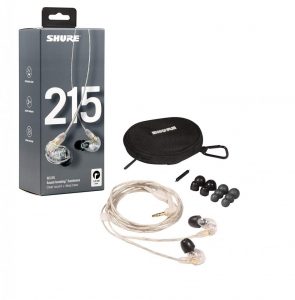 Shure SE215-CL Sound Isolating Earphones come with a Fit Kit which includes 6 pairs of flex and black foam sleeves in three different sizes (S, M, L). With this many choices, you can choose just the right size for your ears, ensuring the best sound isolation and most comfort.
Shure SE215-CL Sound Isolating Earphones come with a Fit Kit which includes 6 pairs of flex and black foam sleeves in three different sizes (S, M, L). With this many choices, you can choose just the right size for your ears, ensuring the best sound isolation and most comfort.
The cables are formfitting to your ears, securing their position in your ears and keeping them away from your face. The marshmallowy soft sleeves and formfitting, yet sturdy wires make them the best earplugs for sleeping on the side, which is kind of rare for earplugs. And even if you wriggle a lot during sleep, there is a wireless model. It pairs with most phones and other devices and provides up to 8 hours of battery life and 30 feet of wireless range. The design of the earbuds is the same, so you could say they are the comfiest wireless earbuds for sleeping.
Conclusion
Some people simply prefer wearing earplugs instead of headphones. If you’re one of them, these are the most comfortable in-ear headphones you will find. With their amazing sound quality and durability, paying a little extra for them is worth it.
4. Best budget headphones for sleep: Sleepace Sleep Headphones
Who is it for
If you want to try headband headphones, but you’re not ready to invest a lot of money yet, we would recommend these headphones as a “trial” version.
Pros and Cons of Sleepace Sleep Headphones
| Pros | Cons |
|
|
All you need to know about Sleepace Sleep Headphones
Sleepace Sleep Headphones double as a sleep mask and as headband headphones. They are great for side-sleepers, and for people who are light sleepers.
The thing that singles them out of other headband headphones is the Sleepace app. This app monitors your sleep stages, so it will turn the music off when you have fallen into a deep sleep. When you’ve rested enough, and have gotten into the lightest part of your sleep, the app will slowly wake you up. You can also play the music from the app, such as white noise or ASMR, to your preference.
Sleepace Sleep Headphones Tech Specs & Accessories
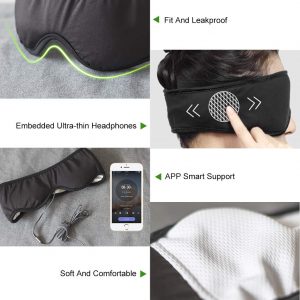 Although they aren’t sound-blocking headphones for sleeping, they do provide a clear sound, which is great for ASMR and white noise music. Headphones are ultra-thin and are positioned inside the headband. They tend to move inside the headband, but they can be sewed on, if that is an annoyance.
Although they aren’t sound-blocking headphones for sleeping, they do provide a clear sound, which is great for ASMR and white noise music. Headphones are ultra-thin and are positioned inside the headband. They tend to move inside the headband, but they can be sewed on, if that is an annoyance.
The headband comes in four different sizes (S, M, L, XL) and is made out of silk and lycra, making it breathable and comfortable to sleep in, even during the summer. Unfortunately, it comes only in one color – black.
It has a lengthy cable (62.20”), which is long enough for you not to worry about knocking your phone off of the night table.
Conclusion
These headphones are a great choice for their price. If you’re on a tight budget and need something to help you fall asleep, Sleepace Sleep Headphones should be your first choice.
5. Editors Pick – Best Value for Money: CozyPhones Sleep Headphones
Who is it for
CozyPhones Sleep Headphones are the best value for money headband headphones. Apart from using them for sleep, you can also use them for different activities, such as exercise, yoga, walks by the beach etc.
Pros and Cons of CozyPhones Sleep Headphones
| Pros | Cons |
|
|
All you need to know about CozyPhones Sleep Headphones
CozyPhones were made with the intent to make cozy sleep headphones for an affordable price. They are great for people who don’t have serious issues falling asleep such as loud environments or light sleep. They are made for anyone that simply falls asleep faster when listening to audiobooks, podcasts or white noise. Like most of the headband headphones, you can also use it as a sleeping mask.
Similar to other sleep headband headphones, the sound quality isn’t perfect or too loud. But, keep in mind that they are made to be cozy and comfortable for your sleep, so sound quality is secondary.
CozyPhones Sleep Headphones Tech Specs & Accessories

CozyPhones headband is made out of fleece material on the outside, while the inner part is mesh. It comes in two colors: black and grey. Different sizes are also available.
The headband is machine washable, which comes in handy especially if you intend on using it for other activities other than sleeping (eg. exercise). The recurring issue with it is that the headphones usually move around it, so you have to adjust them every time you put the headband on. It can be a bit tiresome, but it is worth it for a cozy night of sleep.
The cable is 52” long, which is more than enough to provide you with a lot of space for tossing and turning. The cord is braided, so it can withstand all the tugging during the night.
CozyPhones come in a clear plastic bag, but if you want a travel bag with it you should look at the Contour Series.
Conclusion
Some of the CozyPhones users say they are almost as comfortable and high quality as their more expensive counterparts. There are some differences, of course. But if you don’t wish for the best of the best, but for something that will help you fall asleep all cozied up – these are the headphones for you.
Guide: What You Need to Know When Choosing Headphones You Can Sleep With
A good night’s sleep is one of the most important elements for a successful day and good health. With more people moving to cities, with loud traffic, inconsiderate neighbors and fast lifestyles – a good night’s sleep became a luxury. This is why your ears and your mind need something luxurious, also. Sleep headphones are designed with comfort in mind. These are the things you should consider when buying headphones for sleep.
1. Which are the Best Headphones Brands (making great headphones for sleeping)?
There are good headphone brands we all know about because of their long tradition in making headphones such as Panasonic, Bose, Sennheiser, Bang & Olufsen and Shure. Naturally, their well-known esteem is due to their high-quality products. Some of them, such as Bose have developed entire series dedicated to noise cancellation and relaxation, such as the QuietComfort series. Some of the best earbud brands, such as Shure and Sennheiser offer the best passive noise-cancellation with the best in-ear monitoring technologies and sound quality.
Recently, many specialized companies such as Sleepace, Oittm, AcousticSheep and CozyPhones have been popping up. They mainly specialize in making audio products for sleep and relaxation. Most of them specialize in making headband headphones, bringing comfortable sleep to everyone. Some of them, such as Oittm, go a step further and specialize in making pillows that play music and monitor your sleep.
With so many choices nowadays, yours is to scour the internet and try to find the best suiting pair of headphones, so you can finally get some sleep. And we are here to help you!
2. Comfort When Sleeping with Headphones
As long as you’re here, reading this article, we can suppose you’re a light sleeper that needs certain criteria to be met so you could fall asleep. One of them is surely comfort.
Everything would be easier if you could fall asleep just laying on your back, wouldn’t it? But it happens that you’re a side sleeper, so traditional headphones that hurt your ears are out of the question. Or you toss and turn a lot during the night and always get wrapped up into cords. Or you just can’t find that perfect pair of earbuds that actually stay in your ears during the night, without them jamming too deep into your ear canals.
You’ve probably spent hours googling how to make headphones more comfortable or searching for alternatives to earplugs for sleeping that make your ears sore in the morning. So far, the most comfortable solution for these problems are the noise-masking headbands. In the last few years, a number of different headbands are available, offering comfort to any kind of sleeper. With them side sleepers can finally fall asleep peacefully while listening to music.
For the lucky ones who can fall asleep on their backs, headphones that offer higher sound quality might be better. With no comfort issues narrowing your choices, there is a variety of headphones available to choose from: traditional headphones, clip-on headphones, or earbuds. It is up to you to choose the most comfortable earphones, that provide the sound quality you enjoy listening to during your sleep.
Earbuds and Earphones vs Headphones vs Headbands – Which Headphone Type Should You Choose
Choosing the right headphones is crucial for your sleep. You want them to be comfortable, to provide good sound quality and to mask or cancel the ambient noises as much as they can. Below we will discuss the good and the bad for every type of sleeping headphones.
Over-ear/traditional headphones
Traditional headphones are still the most prominent headphones in terms of sound-blocking and sound quality. Most headphones are big enough to cover your whole ear, blocking out the ambient sound, assuring you can enjoy your music to the fullest. While they do ensure maximum enjoyment, they aren’t the comfiest headphones to sleep in, especially for side sleepers. There have been some improvements in this area, meaning there are companies that have been developing over-ear headphones so soft that you can actually sleep on the side while wearing them. It still sounds a bit uncomfortable to us, but if you’re a big fan of traditional headphones, you should give it a try.
Clip-on/on-ear headphones
On-ear headphones are good for anybody who can’t stand the feeling of earbuds in their ears, but still finds the traditional headphones too big. These headphones are right in the middle. They provide good sound quality and offer a good balance of blocking the ambient noise, while allowing you to be aware of your surroundings. But, sleeping with them, especially on the side, is very uncomfortable. They pressure the ears from the front (headphones) and from the behind (clips). If you’re still keen on using the on-ear headphones for sleep, we do recommend looking into headphones with a thin profile, to minimize the discomfort.
In-ear headphones/earbuds
In-ear headphones are the most frequently used headphones nowadays. Being compact, small and easy to use, they are usually everybody’s first choice when buying headphones. They provide excellent sound isolation, especially if they fit well. Although they are small, some people feel discomfort when sleeping on the side while wearing them. There are different ear sleeves that can relieve the pressure they put on ear canals, making them more bearable to sleep with. Lack of comfort isn’t the only thing worrying about earbuds. Sleeping with earbuds every night can lead to ear infections, so that is something to be careful about.
Headbands and sleep masks
The latest trend in the audio industry are the sleeping headband headphones and masks. They are currently the most comfortable headphones to wear for sleeping, by far. After all, they are designed for it. They come in different shapes and styles, so anybody can find just the right model for them. Although they are very comfortable, they can’t compete as the best sound-blocking headphones for sleeping. Generally speaking, sleeping headphones lack quality in one important aspect – sound. They compensate that with being comfy, but if you find sound quality extremely important, sleeping headphones won’t impress you.
Wireless vs Wired Headphones and their pros and cons
Another important aspect to consider when buying sleeping headphones is whether to go with wireless or wired headphones.
While wireless headphones definitely provide more freedom and comfort during the night, you have to think about charging it every single day, or you won’t have your sleeping headphones for the night. Battery lifespan often decreases over time, and sometimes, depending on the battery quality, that can happen over a very short period of time. So, it is always smart to check the customer reviews of the headphones you intended to buy, just to make sure everything works the way it was advertised. When buying Bluetooth sleep headphones, also check the range they have for easy connectivity. The last thing you want is the connection breaking and disturbing your sleep.
If you don’t want to bother with all that, then you should go with wired headphones. After all they do provide better sound quality. Look into buying headphones with durable, long cords (at least 30”) so you don’t have to worry about tugging your phone off of the nightstand during the night. But, be prepared to wake up all tangled up if you toss and turn during the night.
Even though wireless headphones do require a bit more responsibility when choosing them and with charging them every day, they still compensate that with the comfort of not thinking about pulling your phone down form the nightstand, or the position you’ll sleep in during the night so you don’t wake up with a cord around your neck.
Sound Quality vs Comfort
As it was mentioned a few times through this buyers guide, comfortable headphones do come at a price of lower sound quality. Sleeping headphones are fairly new to the market, so there is still time to perfect that feature in them. But, until that happens this is what you need to know about the Sound Quality vs Comfort conflict.
If you’re a light sleeper that sleeps in a loud environment, investing in a pair of good comfy headphones to keep you asleep during the night is probably the best. Even though wireless headphones do have worse sound quality, it is usually not that bad that it’ll prevent you from falling asleep. There are more chances for you to be awakened by a cord tangled around your arm or by a sore ear, than by a bad instrumental part of the song. Also, keep in mind that all the headphones we reviewed have the satisfying sound quality, that won’t disturb your sleep.
If you want to use headphones just so you could stop the brain chatter and calm yourself before sleep, you might not need headphones especially made for sleep. If that’s the case, maybe the best option for you would be buying a pair of high quality wired headphones, which can be used both for day-time activities and for lulling you to sleep. But, if you want to sleep with them all through the night, noise-masking headbands are still the best choice.
Volume Threshold
Our parents and grandparents weren’t mistaken when they criticized our obsessive need to listen to loud music on our headphones throughout our teenage period. Loud music can severely influence hearing loss and other hearing problems. A study was conducted among Swedish adolescents, where it was proven that individuals that listened to music for more than three hours a day and at higher noise levels (above 90 dB) had poorer mean hearing thresholds. Apart from that, listening to music at higher volumes can lead to tinnitus and other hearing impairments.
This being said, take the volume threshold of your headphones seriously. Your sleeping headphones should have a wide volume threshold, so you could listen to your music at a low volume setting (below 60 dB) during sleep. Also, when creating your sleeping playlist, keep in mind that volume levels can vary from song to song. To prevent any loud or sudden sounds, it is also wise to limit the volume at the source, as most of the smartphones now allow you to set your own default volume levels.
Noise Masking and Noise Canceling
Noise isolation, noise canceling and noise masking are different terms you need to understand so you could choose the right type of headphones for you.
Noise isolating headphones physically block the ambient noise around you. They usually come in form of traditional, over the head headphones or earphones. The degree to which they block out the ambient noise depends on how the headphones fit inside or over your ear. This is why it is very important to choose the right size of headphones when buying noise-isolating headphones.
Noise canceling headphones usually block the noise both physically and electronically. They use microphones to scan the noise around you, process it and create inverse waves which are then sent back to your headphones, thus canceling the ambient noise around you. This is quite high-tech, but it still doesn’t work perfectly. It will work great with background noises such as an annoying fan or plane engine during the flight. It won’t do miracles with blocking the loud music your upstairs neighbors play, or with the barking of your dog. This is where the physical noise-blocking comes in handy, decreasing those noises to a considerable extent.
And last but not the least, noise masking. Noise masking relies on digitally creating another sound that will cover up other distractions. The sound they emit is an unnoticeable background sound, so soft, the listener doesn’t notice it. This way, noisy distractions such as snoring or people talking are muffled, making it easier for you to fall asleep.
3. Dangers of Sleeping with Headphones On
There are some minor threats you should be aware of when sleeping with headphones. But, luckily, all of them are preventable by choosing the right pair of headphones to sleep in.
Maybe the most realistic scenario, that can really make you regret sleeping with headphones, are the health issues they can cause. This usually happens if you don’t pay enough attention, or choose the wrong headphones for you, so we will help you prevent it.
Listening to music for long periods of time on noise levels higher than 60 dB, can cause serious damages to your hearing. Hearing loss and conditions like tinnitus are likely to develop in this case. This is why it’s very important to pay attention to the volume threshold of your headphones and to keep the music playing below 60 dB.
Another condition that can develop is otitis externa, or better known as an outer ear infection. It’s usually caused by the bacteria developing in the damaged skin of the outer ear canal. Skin can be damaged by cotton swabs, intense scratching or by sleeping with earbuds that don’t really fit you, thus irritating your ear canal. If you don’t realize right away how the infection started in the first place, it can be prolonged since you’ll be using the same pair of bacteria-bearing earphones over and over again. These are some of the most common side effects when sleeping with earplugs.
If you’re sleeping in a loud environment and use active noise-cancellation headphones, you’re probably not aware of your surroundings. This means you might not hear the fire-alarm or someone breaking into your apartment. If you’re afraid of something like that happening, noise-isolating headphones will also serve you good.
There are some very obvious “dangers” in sleeping with headphones, such as tangling up in cords while you sleep, or getting uncomfortable during the night if they put pressure onto your ears. These problems can be easily solved by buying wireless, headband headphones. One danger that seems silly, but you might not think of – is the quality of your playlist. It’s important to make a calming playlist for your sleep, with songs that are in the same volume range. You don’t want the shock of going from calming raining sounds to AC/DC during your sleep, do you? This can also be tricky if you’re listening to YouTube when you’re sleeping. If you do that, do install adblocker, so your sleep wouldn’t be interrupted with loud ads.
Is Listening to Music While Sleeping Dangerous?
A number of studies have been conducted to determine whether it is bad to listen to music while sleeping. Most of them didn’t find any downsides to sleeping with music. On the contrary, they found that music can improve sleep quality to everybody, from elementary school children to older adults. They got positive results regarding sleep efficiency and sleep duration. In a study that included students aging from 19 to 28 years old, a decrease in depressive symptoms was also noticed.
If you’re listening to music at low volumes during the night, there is nothing you should worry about. Not only music isn’t dangerous to listen to while sleeping, but it can also benefit you.
Can Side Sleepers Sleep with Headphones?
Side sleepers can find it challenging to choose the right headphones that will be comfortable enough to wear while sleeping. Opting out for headband headphones will certainly solve their problems as they were made especially for side sleepers.
Can Kids Sleep with Headphones?
In general, there are no real dangers for kids to sleep with headphones. If you monitor the noise, which should be below 60 dB, there shouldn’t be any harm done. There are headphones specially made for kids, that limit the output volume to safe listening levels.
If you’re not sure about your kid listening to music the whole night, but have a problem with them waking up every now and then because of loud noises, there are ear muffs specially made for kids which can help reduce noise for 25 dB.
Which Music to Choose While Sleeping?
Choosing the right music to listen to while sleeping, is maybe as important as choosing the right pair of sleep headphones. Clearly, you don’t want music that will keep you up. This includes all the songs with lyrics, and some may say even some instrumental songs. Most songs were made to elevate your emotions, your thoughts, to make you feel excited. This is the opposite of what you want to feel when you’re falling asleep. The key is listening to soft sleep music, that will soothe your mind, relax your body and chase the stress away. As there is a growing number of people that are sleeping with music, several sleeping music “genres” have developed since.
ASMR (Autonomous Sensory Meridian Response)
ASMR (Autonomous Sensory Meridian Response) tracks aren’t really music, but are helping a lot of people relax and fall asleep quicker. Actually, ASMR is a tingling, bubbly sensation on the skin, that is caused by listening to sounds such as soft whispering, chewing, someone turning pages on the books or cutting vegetables. It became widely popular in the last few years and YouTube is loaded with different ASMR videos. Some people find it strangely relaxing, some find it extremely annoying. If you belong to the first group of people, you will probably find something that soothes you on YouTube.
Meditation Music for Sleep
If you have a problem with mental chatter and relaxing before falling asleep, meditation music might help you with that. You can choose the sounds that suit you the best. Some people like the simple repetitive sounds that help them normalize their breathing, others like the sounds of nature. There are a number of apps and videos on YouTube, all you have to do is to choose.
Binaural Sleep Music
You’ve probably encountered various “binaural music to study/relax/sleep to” videos. So what is binaural sleep music actually? Binaural music is relaxing music that is entwined with binaural beats, that are believed to be able to entrain our brainwaves, so a certain state of mind is achieved. To achieve it, you must listen to it through headphones, so one frequency can be played to your left ear and a slightly different frequency to your right ear. By doing this, the brain interprets two frequencies as a third sound, which is the same frequency as our brainwaves are when we’re relaxed. By listening to that frequency, our brainwaves will align with it, thus making us feel relaxed. Although there are no scientific papers supporting this theory yet, a lot of people find it soothing and relaxing, so it became popular really quickly.
White Noise
White noise is a spectrum of frequencies that help block out background sounds. It is often mixed with the soothing sounds of rain, nature or wind. It is very popular across YouTube as sleep music, with tracks lasting for more than 10 hours, which is long enough to keep you asleep the whole night.
Brain.FM
Brain.FM is an online service that provide a wide range of sounds for different purposes – to focus, relax or sleep. It is designed to improve your sleep in just 15 minutes. It’s definitely worth checking out if you want to try something new. Check out our Brain.FM review here.


